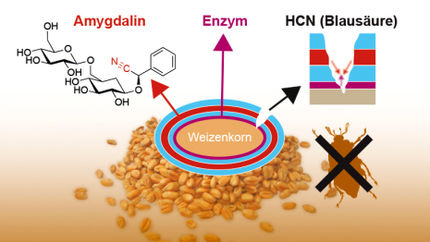New coating is self-defence for seeds
Advertisement
Scientists in Switzerland have developed a protective coating for seeds that poisons pests with cyanide when they bite into it.
The coating is a system of two layers and only becomes toxic when the layers are mixed, eliminating the problem of environmental contamination that is associated with current pesticides. The researchers based the system on a form of natural protection many plants use for protection against herbivores, like apples. Apple seeds contain the chemical amygdalin or other cyano-glycosides, which reacts with enzymes to release the toxic chemical hydrogen cyanide to protect them from attack by insects.
The artificial coating, which could be used on as-yet unprotected seeds such as wheat, is made from a layer of the enzyme hydroxynitrile lyase and a layer of polylactic acid containing the chemical malonitrile. The two layers are separated by a layer of pure polylactic acid. When a herbivore bites into the seed, the layers merge together. This causes the hydroxynitrile lyase and malonitrile to react with one another to produce hydrogen cyanide by a process called cyanogenesis.
The coating is applied to the seeds only so it is safe for humans to eat the fully-grown crop. However, the researchers found that the coating can reduce the ability of seeds to germinate which could be due to the toxic effect of the coating on the seeds themselves. They are currently working on applying a denser separating layer to reduce the diffusion of hydrogen cyanide towards the centre of the seeds.
Other news from the department science

Get the chemical industry in your inbox
By submitting this form you agree that LUMITOS AG will send you the newsletter(s) selected above by email. Your data will not be passed on to third parties. Your data will be stored and processed in accordance with our data protection regulations. LUMITOS may contact you by email for the purpose of advertising or market and opinion surveys. You can revoke your consent at any time without giving reasons to LUMITOS AG, Ernst-Augustin-Str. 2, 12489 Berlin, Germany or by e-mail at revoke@lumitos.com with effect for the future. In addition, each email contains a link to unsubscribe from the corresponding newsletter.



























































